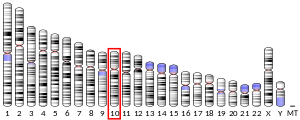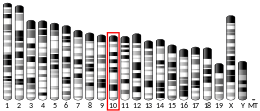MYPN
Myopalladin is a protein that in humans is encoded by the MYPN gene. Myopalladin is a muscle protein responsible for tethering proteins at the Z-disc and for communicating between the sarcomere and the nucleus in cardiac and skeletal muscle[5][6][7]
Structure
Myopalladin is a 145.2 kDa protein composed of 1320 amino acids.[8][9] Myopalladin has five Ig-like repeats within the protein, and a proline-rich domain. Myopalladin binds the Src homology domain of nebulette and nebulin and tethers it to alpha-actinin via its C-terminal domain binding to the EF hand domains of alpha-actinin. The N-terminal region of myopalladin binds to the nuclear protein CARP, known to regulate gene expression in muscle.[5] It also has been shown to bind ANKRD23.[10]
Function
Myopalladin has dual subcellular localization, residing in both the nucleus and sarcomere/I-bands in muscle. Accordingly, myopalladin has functions in both sarcomere assembly and in control of gene expression.[5] Specifics of these functions were gleaned from studies involving MYPN mutants associated with various cardiomyopathies. The Q529X myopalladin mutant demonstrated incompetence in recruiting key binding partners such as desmin, alpha-actinin and CARP to the Z-disc during myofibrilogenesis. In contrast, the Y20C mutant resulted in decreased expression of binding partners.[11]
Clinical significance
Mutations in MYPN have been linked to dilated cardiomyopathy, hypertrophic cardiomyopathy and restrictive cardiomyopathy.[11][12]
References
- GRCh38: Ensembl release 89: ENSG00000138347 - Ensembl, May 2017
- GRCm38: Ensembl release 89: ENSMUSG00000020067 - Ensembl, May 2017
- "Human PubMed Reference:". National Center for Biotechnology Information, U.S. National Library of Medicine.
- "Mouse PubMed Reference:". National Center for Biotechnology Information, U.S. National Library of Medicine.
- Bang ML, Mudry RE, McElhinny AS, Trombitás K, Geach AJ, Yamasaki R, Sorimachi H, Granzier H, Gregorio CC, Labeit S (April 2001). "Myopalladin, a novel 145-kilodalton sarcomeric protein with multiple roles in Z-disc and I-band protein assemblies". The Journal of Cell Biology. 153 (2): 413–27. doi:10.1083/jcb.153.2.413. PMC 2169455. PMID 11309420.
- Ma K, Wang K (December 2002). "Interaction of nebulin SH3 domain with titin PEVK and myopalladin: implications for the signaling and assembly role of titin and nebulin". FEBS Letters. 532 (3): 273–8. doi:10.1016/S0014-5793(02)03655-4. PMID 12482578.
- "Entrez Gene: MYPN myopalladin".
- Chung, Joon-Sub. "Protein Information - Myopalladin". Cardiac Organellar Protein Atlas Knowledgebase (COPaKB). NHLBI Proteomics Center at UCLA. Retrieved 2015-04-29.
- Zong NC, Li H, Li H, Lam MP, Jimenez RC, Kim CS, Deng N, Kim AK, Choi JH, Zelaya I, Liem D, Meyer D, Odeberg J, Fang C, Lu HJ, Xu T, Weiss J, Duan H, Uhlen M, Yates JR, Apweiler R, Ge J, Hermjakob H, Ping P (October 2013). "Integration of cardiac proteome biology and medicine by a specialized knowledgebase". Circulation Research. 113 (9): 1043–53. doi:10.1161/CIRCRESAHA.113.301151. PMC 4076475. PMID 23965338.
- Miller MK, Bang ML, Witt CC, Labeit D, Trombitas C, Watanabe K, Granzier H, McElhinny AS, Gregorio CC, Labeit S (November 2003). "The muscle ankyrin repeat proteins: CARP, ankrd2/Arpp and DARP as a family of titin filament-based stress response molecules". Journal of Molecular Biology. 333 (5): 951–64. doi:10.1016/j.jmb.2003.09.012. PMID 14583192.
- Purevjav E, Arimura T, Augustin S, Huby AC, Takagi K, Nunoda S, Kearney DL, Taylor MD, Terasaki F, Bos JM, Ommen SR, Shibata H, Takahashi M, Itoh-Satoh M, McKenna WJ, Murphy RT, Labeit S, Yamanaka Y, Machida N, Park JE, Alexander PM, Weintraub RG, Kitaura Y, Ackerman MJ, Kimura A, Towbin JA (May 2012). "Molecular basis for clinical heterogeneity in inherited cardiomyopathies due to myopalladin mutations". Human Molecular Genetics. 21 (9): 2039–53. doi:10.1093/hmg/dds022. PMC 3315208. PMID 22286171.
- Duboscq-Bidot L, Xu P, Charron P, Neyroud N, Dilanian G, Millaire A, Bors V, Komajda M, Villard E (January 2008). "Mutations in the Z-band protein myopalladin gene and idiopathic dilated cardiomyopathy". Cardiovascular Research. 77 (1): 118–25. doi:10.1093/cvr/cvm015. PMID 18006477.
Further reading
- Hartley JL, Temple GF, Brasch MA (November 2000). "DNA cloning using in vitro site-specific recombination". Genome Research. 10 (11): 1788–95. doi:10.1101/gr.143000. PMC 310948. PMID 11076863.
- Wiemann S, Weil B, Wellenreuther R, Gassenhuber J, Glassl S, Ansorge W, Böcher M, Blöcker H, Bauersachs S, Blum H, Lauber J, Düsterhöft A, Beyer A, Köhrer K, Strack N, Mewes HW, Ottenwälder B, Obermaier B, Tampe J, Heubner D, Wambutt R, Korn B, Klein M, Poustka A (March 2001). "Toward a catalog of human genes and proteins: sequencing and analysis of 500 novel complete protein coding human cDNAs". Genome Research. 11 (3): 422–35. doi:10.1101/gr.GR1547R. PMC 311072. PMID 11230166.
- Miller MK, Bang ML, Witt CC, Labeit D, Trombitas C, Watanabe K, Granzier H, McElhinny AS, Gregorio CC, Labeit S (November 2003). "The muscle ankyrin repeat proteins: CARP, ankrd2/Arpp and DARP as a family of titin filament-based stress response molecules". Journal of Molecular Biology. 333 (5): 951–64. doi:10.1016/j.jmb.2003.09.012. PMID 14583192.
- Wiemann S, Arlt D, Huber W, Wellenreuther R, Schleeger S, Mehrle A, Bechtel S, Sauermann M, Korf U, Pepperkok R, Sültmann H, Poustka A (October 2004). "From ORFeome to biology: a functional genomics pipeline". Genome Research. 14 (10B): 2136–44. doi:10.1101/gr.2576704. PMC 528930. PMID 15489336.
- Mehrle A, Rosenfelder H, Schupp I, del Val C, Arlt D, Hahne F, Bechtel S, Simpson J, Hofmann O, Hide W, Glatting KH, Huber W, Pepperkok R, Poustka A, Wiemann S (January 2006). "The LIFEdb database in 2006". Nucleic Acids Research. 34 (Database issue): D415–8. doi:10.1093/nar/gkj139. PMC 1347501. PMID 16381901.
- Beausoleil SA, Villén J, Gerber SA, Rush J, Gygi SP (October 2006). "A probability-based approach for high-throughput protein phosphorylation analysis and site localization". Nature Biotechnology. 24 (10): 1285–92. doi:10.1038/nbt1240. PMID 16964243.



